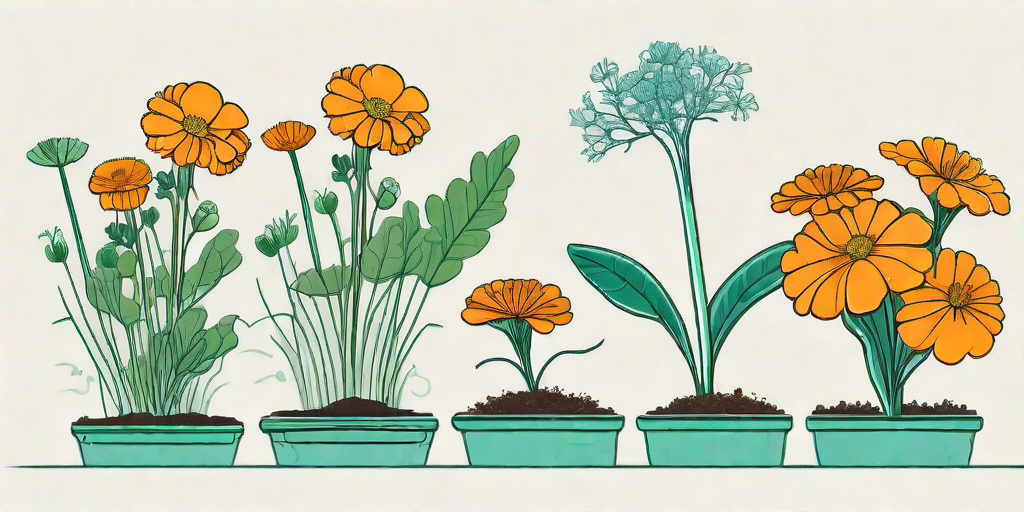
Marigolds, with their vibrant hues and aromatic allure, are the divas of the garden world. But fear not, dear reader, for these divas are not high-maintenance. In fact, they are quite the opposite. With a little love and care, you can transform tiny marigold seeds into blooming beauties. So, let's dive into the world of marigold cultivation, shall we?
The Marigold Basics
Before we get our hands dirty, let's get to know our starlets a little better. Marigolds, scientifically known as Tagetes, are native to North and South America. They come in a variety of species, each with its unique charm and characteristics. From the petite French Marigold (Tagetes patula) to the towering African Marigold (Tagetes erecta), there's a marigold for every garden.
Marigolds are annual plants, meaning they complete their life cycle in one growing season. They are sun-loving divas, thriving in full sun and well-drained soil. But what makes them truly stand out is their resilience. Marigolds are tough cookies, resistant to most pests and diseases. They are the perfect choice for novice gardeners or those with a knack for killing plants (you know who you are).
Marigold Varieties
Choosing a marigold variety can be as challenging as picking a favorite ice cream flavor. There are just too many delicious options! Here are a few popular ones to consider:
- French Marigold: Compact and bushy, these marigolds are perfect for borders and containers. They come in a range of colors, from deep reds to bright yellows.
- African Marigold: These are the skyscrapers of the marigold world, reaching heights of up to 3 feet. Their large, pom-pom-like flowers are a sight to behold.
- Signet Marigold: With their dainty, daisy-like flowers and lacy foliage, these marigolds are perfect for adding a touch of elegance to your garden.
How to Grow Marigold Seedlings
Now that we've covered the basics, let's roll up our sleeves and get to the fun part: growing marigold seedlings. The process is as easy as pie, or should we say, as easy as planting a seed.
Start by choosing a high-quality seed mix. Remember, your marigolds are divas, and divas deserve the best. Next, fill a seed tray or pots with the seed mix and sow the marigold seeds about 1 inch apart. Cover the seeds lightly with soil and water them gently. Place the tray in a sunny spot and wait for the magic to happen.
Germination
Marigold seeds are eager beavers. They typically germinate within a week of sowing. Once the seedlings have sprouted, make sure they receive plenty of sunlight. If you're growing them indoors, consider using a grow light to supplement natural light.
Water the seedlings regularly but avoid overwatering. Remember, marigolds are like cats - they don't like wet feet. Once the seedlings have developed a couple of true leaves (the ones that look like actual marigold leaves), they are ready to be transplanted.
Transplanting
Transplanting is like the debutante ball for your marigold seedlings. It's their first introduction to the big, wide world. To ensure a smooth transition, choose a sunny spot with well-drained soil. Dig a hole large enough to accommodate the seedling's root ball, place the seedling in the hole, and backfill with soil.
Water the transplanted seedlings thoroughly and continue to water them regularly. In a few weeks, your marigold seedlings will transform into blooming beauties, adding a splash of color to your garden.
Caring for Your Marigolds
Marigolds are low-maintenance divas. They don't require much pampering, but a little TLC can go a long way in ensuring a spectacular bloom. Here are some care tips:
- Watering: Marigolds prefer their soil to be slightly dry rather than too wet. Water them deeply but infrequently.
- Fertilizing: While marigolds aren't heavy feeders, a light application of a balanced fertilizer can boost their growth and flowering.
- Deadheading: Remove spent flowers to encourage more blooms. Plus, it keeps your marigolds looking neat and tidy.
Frequently Asked Questions
Can I grow marigolds indoors?
Yes, you can grow marigolds indoors. However, they need plenty of sunlight, so make sure to place them near a sunny window or use a grow light.
Are marigolds deer resistant?
Yes, marigolds are deer resistant. Their strong scent acts as a natural deer deterrent. So, if Bambi's been munching on your garden, marigolds could be your new best friend.
Can I use marigolds as companion plants?
Absolutely! Marigolds are excellent companion plants. Their strong scent repels many pests, and they are particularly effective at deterring nematodes.
So, there you have it, folks. From tiny sprouts to blooming beauties, growing marigold seedlings is a rewarding experience. With their vibrant colors and easy-care nature, marigolds are the perfect addition to any garden. So, why not give it a try? After all, every diva deserves her moment in the sun.















